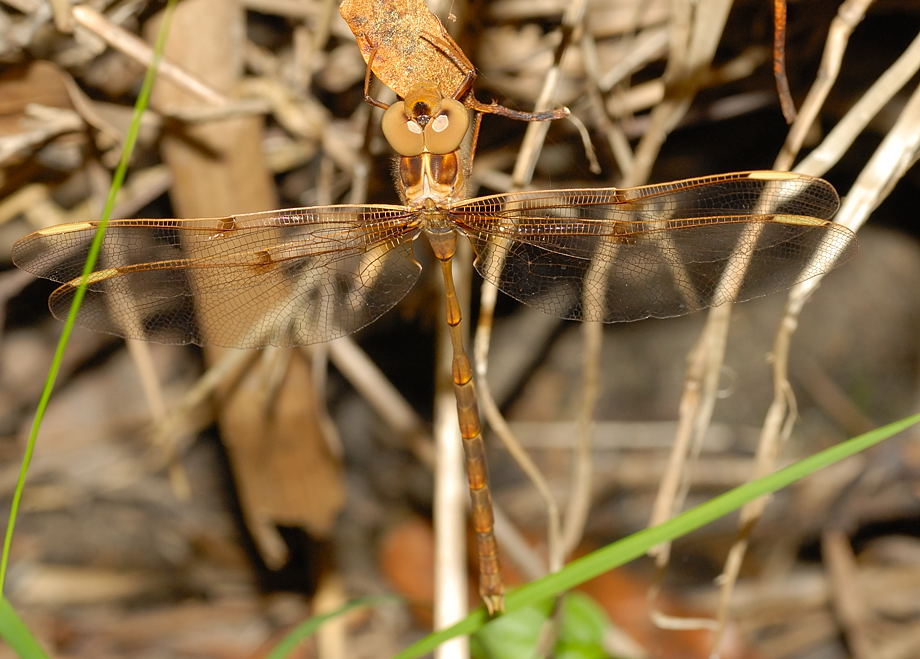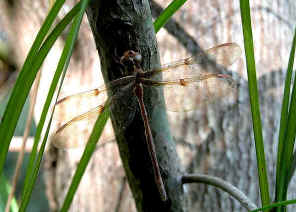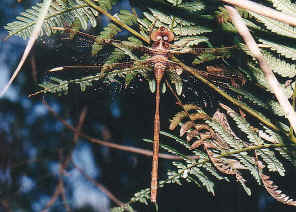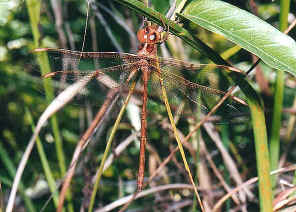|
| |
FAMILY TELEPHEBIIDAE
- This page contains pictures and information about Coastal Evening Darners that we found in the Brisbane area, Queensland, Australia.
-
 - Male, body length 75mm
-
- The Coastal Evening Darner dragonflies are brown in colour, with white
strips on the thorax. The wings are clean with all front edges marked with
brown bands. The pterostigmas are creamy white in colour.
-
 
 -
- The Coastal Evening Darners are one of the crepuscular species. Unlike
most other dragonflies active in sunny day, they are active during the
period of evening twilight. During the day the dragonflies spend most of the time hanging vertically within plants.
They fly a few meters away when disturbed. They fly slowly and not in the way
you may expect from other dragonflies. They fly like a lacewing, slow and
weak. They active at dusk till early night.
-


 -
- On a early summer day in Yugarapul Park along Bulimba Creek, we were
bush-walking
and looking for insects to photo. We saw an insect flying away from us slowly
with white pterostigmas on wings. We thought it was a lacewing. The
insect rested vertically hanging on a small tree, with wings extended like a
dragonfly. When we came closer, it flied to the other side of the creek and we
could not follow. We thought it could be a dragonfly that we never saw before.
-
 
 - Male
Female
-
- A week later we came back to the same place and tried our luck if we could
see the insect again. At first we only saw some Blue
Eyes Lacewings. After hours of
searching, we gave up. We started to believe the insect we saw a week before
was just a common lacewing. When we were packing up and ready to go, we saw an insect
flied pass and rest a few meters in front of us. We saw it clearly and it was a dragonfly.
We saw the similar species on pictures before. We did not expect to see this
dragonfly species there.
-
   -
- We followed the dragonfly carefully and it leaded us to a place where could
be their hiding place. There we saw quite a number of the dragonflies hiding,
when we moved, some of them flied away from us. The place was tens of meters from
the creek, and it was a boggy seepage. The place is covered by dense and very
tall trees, and not much sun light. The dragonflies were hiding among
the lower plants, half a meter above ground..
-
   -
- The male Coastal Evening Darner look similar as the female except his
angulated hindwings and his long
anal appendages at the abdomen tips. He uses those anal appendages to hold the
female when mating.
-
- The above left picture shows a male Coastal Evening Darner dragonfly get caught in a spider web.
-
- The larvae are known living in semi-aquatic and terrestrial habitats.
-
-


 -
- We found on in Ford Road Conservation area on Jan 2009.
-

 -
- Reference and Link:
- 1. The Australian Dragonflies - Watson, J.A.L., Theischinger,
G., Abbey, H.M. 1991, CSIRO Publications, pp 195.
- 2. Telephlebia tryoni
- Australian Insect Common Names, CSIRO, 2005.
- 3. Telephlebia tryoni
- Australian Biological Resources Study, Department of the Environment and
Heritage2005.
- 4. A
Field Guide to Dragonflies of South East Queensland - Ric Nattrass,
2006, p58.
- 5. The
Complete Field Guide to Dragonflies of Australia - CSIRO, GŁnther
Theischinger and John Hawking, 2006, p144.
- 6. Telephlebia cyclops - Deniss Reeves, Austrolestes-Newsletter
of Australian Dragonfly Society, summer 2001.
- 7. Australian Crepuscular Dragonflies - Deniss Reeves,
Austrolestes-Newsletter of Australian Dragonfly Society, #8, 2003.
Back to Top
[ Up ] [ Unicorn Darner ] [ Coastal Evening Darner ]
| |
|





















